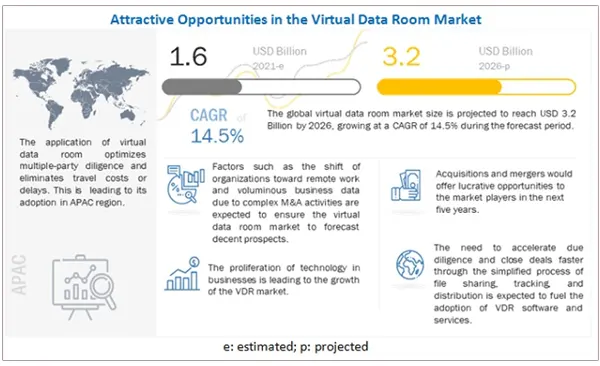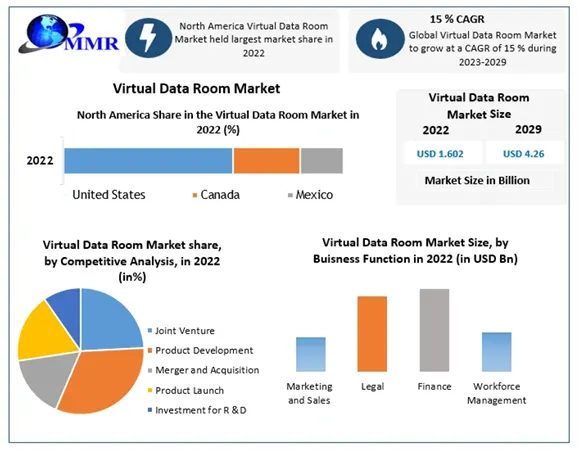
Information Technology has increased the productivity of businesses and processes with the introduction of (VDR) Virtual Data Rooms. The global virtual data room software market has seen an upward trend in the last few years.
According to market analysts, the VDR market was valued at $1.38 billion in 2020, $1.6 billion in 2021, and rose to $2.2 billion in 2022. These digits will be $3.2 billion by 2026, exhibiting a CAGR of 14.5% between 2021 and 2026.
How is the industry growing at such a rapid pace, and what triggered it? This article will provide the desired answers and details of the current data room market trends!
Major Causes Behind Virtual Data Room Market Growth
A virtual data room is an online storage that stores confidential documents securely. It is a digital version of a data storage room that stores and exchanges sensitive information about business transactions.
Online data rooms are not new technology and have been in the industry for almost two decades. Since the demand for the digitalization of documents increased in the industry, the VDR market has seen exponential growth.

Nowadays, almost every business uses the services of the digital data room market to stand apart from the competitors, giving rise to market growth. We will discuss these causes in the section below in detail.
Digitalization
The VDR market has shown immense growth due to the increasing demand for exchanging important documents with high security. Digitalization across organizations and legal authorities is propelling market growth in the 21st century.
Corporations are shifting to cloud technology as it offers numerous benefits and digital development. Many companies are now opting for this paperless innovation to reduce the stress of manual labor.
Did You Know? The global virtual data room market size was valued at USD 2.23 billion in 2023.
Data room services are cloud-based document repositories with advanced data management features. They can eliminate the need for in-house digital or paper databases and are way more affordable than any other document management solution.
Medical equipment and clinical research businesses are required to maintain the confidentiality of classified medical information, which creates the need for a stable and secure data storage platform. The virtual data room fulfills their needs and becomes a reliable platform.
Digital Data Security
Digitalization has its perks, as it automates complex processes, but the reality hits hard when hackers wreak havoc on businesses and confidential information.
Cybercrime is one of the notable side effects of digitalization, as hundreds of businesses lose their precious data every year due to insecure data storage tools and pay heavy financial penalties.
Digital data room ensures a robust internal-external security system and lowers the risk of data theft. It safeguards your data from hackers, third parties, and internal employees.
If you opt for the best software, you can enjoy the latest security features like fence view mode, remote device purging, IP access control, digital watermarks, document shredding, 256-bit SSL data encryption, and multifactor authorization.
Pro-tip: Always consider security when choosing data room software. One of the best research methods is to read online virtual data room review
Covid-19 Lockdowns
The COVID-19 pandemic also played a huge role in letting companies know about these multipurpose solutions — virtual data rooms. The global mandatory lockdowns pushed businesses to go digital, and work-from-home became a new norm.
Virtual data rooms became famous in the corporate world during the pandemic and post-COVID-19 era. VDRs provide a virtual workspace for businesses and employees to store, share, manage data, and use the built-in communication tools.
Data room software also helped companies streamline business processes like internal and external meetings without compromising security. It served as the virtual office and contributed to the market growth.
Current Data Room Market Regional Insights
In 2022, North America dominated the largest market share in virtual data room technology usage (both cloud and on-premise). The reason was the increasing percentage of mergers and acquisitions in the world.

The above statistics show the virtual data room market growth in North America in 2022.
Asia Pacific comes second in VDR technology usage, followed by Europe in third place. Growing markets like India and China imply the need for secure document transfer solutions.
Business practices have changed for good, and people are more comfortable working from home, and companies like Google have shifted to a hybrid work culture.
The demand for freelancing jobs leaves businesses with no choice but to operate through virtual workplaces like data room software.
Virtual Data Room’s Vertical Users
In addition to mergers and acquisitions, digital data room software facilitates transactions like fundraising, asset trading, joint ventures, strategic partnerships, biotech licensing, initial public offerings, risk management, litigation, and asset management.
The BFSI industry tops the list of VDR consumption based on vertical insights, while retail and e-commerce come second. Energy & utilities, healthcare, telecom & IT, construction, and real estate follow next.
Parting Thoughts

The global VDR market is cherishing consistent growth and is predicted to reach $4.2 billion by 2028. Digital security, M&A activities, and remote work culture are common trends that affect VDR’s market growth.
These digits are expected to increase with the increasing demand for digitalization and business automation processes. Look out for the forthcoming development and growth of the VDR market.







